
Underwater Photography Primer
by Philip Greenspun; revised August 2018
Site Home : Photography : Underwater

by Philip Greenspun; revised August 2018
Site Home : Photography : Underwater
Underwater photography combines the challenges of (1) trying to make an aesthetic statement that hasn't been made by thousands of photographers who've dedicated decades of their life to the craft, with (2) trying to stay alive.
Get into submarine. Get out camera. Point. Shoot. Here are some examples from a 800' dive in the Cayman Islands.
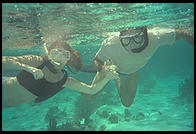
Snorkeling is much simpler than SCUBA diving. The key to snorkeling is to remember that the human body will always float. It just doesn't float high enough that you can breathe easily. However, if you add a few inches of extension to your mouth, your natural floating position will be more than sufficient for breathing. You can thus stay in the water for 8 hours without exerting any energy and wait for interesting subjects to drift or swim underneath.
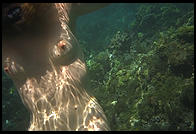
If you're staying near the surface, you don't need a camera that can handle the pressure of deep water. A compact digital camera that has been augmented for snorkeling will work fine. Typically these cameras are specified waterproof to 30-50' but will work a little deeper as well. A good example is the Olympus TG-5. Image quality is mediocre due to the small sensor (similar to what is found in an action camera).
What's a good step up from the waterproof/shockproof point-and-shoot? The Nikon 1 AW1 was part of their 1" sensor plus interchangeable lens camera system. Unfortunately, it was officially discontinued in 2018. Perhaps that is for the best as users found it difficult to prevent leaks. A bigger sensor yet is the APS-C sensor within the Leica X-U (waterproof to 15 meters).
How did it work in the old film days? If you can find a Nikon Action Touch, you might be surprised at how good it was. This camera has a very high quality 35/2.8 lens and autofocus above water. Underwater, you set the subject distance with a convenient dial. There is a nice big switch that turns the built-in flash on or off.
The Action Touch sold for about $150 in the late 1980s, after which Nikon took it off the market and no company ever made a similar camera. The Japanese concluded that nobody is intelligent enough to focus a camera manually. All the cheap underwater cameras introduced after the Action Touch were fixed focus underwater and came with lower quality lenses.
Most film photographers would use slide film despite its attendant narrow exposure tolerance. This may have been because prints can never convey the drama and brilliant colors of the underwater world.
Here are some snapshots from an old Nikon Action Touch:
Note that an "underwater-lite" camera ends up being a great camera for rafting, kayaking, heavy rain, or any other time when you need a high quality waterproof camera but don't need high pressure resistance.
The bad thing about snorkeling is that nearly all of your photos will end up having a "looking down" perspective. Here are a couple from Hawaii (taken with the Nikonos V, described below):
Strap some tanks, ideally filled with Nitrox, on your back and dive. Many compact digital cameras, notably the popular Canon line, are marketed with accessory underwater housings. These rigid plastic cases typically cost around $160 and are designed for use at all recreational SCUBA depths, i.e., down to 130' underwater. A housed camera is never as easy to use as a camera designed specifically for use underwater, so if you are mostly going to be using a camera at snorkel depths, you are better off with a camera from the preceding section.
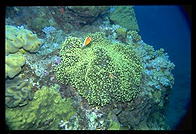
What if a compact digital camera is not an adequate tool for the job? You can put any standard camera into a plastic bag. A plastic bag?!? Not just any plastic bag. A thick German plastic bag made by ewa-marine with a metal screw-down zip-loc top. These ewa guys make plastic bags for cameras of all sizes with various combinations of lenses and flashes.
I have tested some ewa-marine bags. To my amazement, they did not leak. However, I was never able to use them successfully. The last time I tried the ewa bag was on a liveaboard trip to the Great Barrier Reef. The bag was stuffed with a Nikon 8008, SB-24 flash, and 60mm macro lens. As soon as I got to about 30 feet underwater, the bag was pressing up against the camera to the point that the controls were inoperable. The AF drive wasn't strong enough to rack the lens out against the pressure of the bag. The few snapshots produced in this matter were of substandard quality and, with a 20mm lens, there was pronounced vignetting from the housing (example at right).
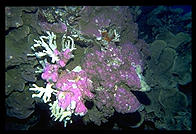
Now that we're deep underwater, let's talk about fundamentals rather than gear for a moment. One fundamental fact is that water magnifies. Thus you end up needing a wider angle lens than you thought. A 20mm lens on a full-frame digital SLR or 35mm film camera is not especially wide for underwater use.
If you have a longer lens, why not just back up? The problem with backing up underwater is that water tends to absorb red and yellow light. The more water between your subject and your lens, the bluer your subject will be. If your light source is on-camera (i.e., if you are using a flash), every extra foot of water between you and the subject addings two feet worth of bluing (one as the light goes from the flash to the subject and one on the way back to the lens).
Underwater photographers are thus very fond of very wide lenses and very powerful flashes.

If we don't like the plastic bag idea, what about going back to the rigid plastic housing idea that works so well for digital point and shoot cameras? We would need a housing custom-designed to enclose a digital SLR body. Then we would need some kind of extension matched to any particular lens that we might mount to that body. Then we would need some way of extending the enclosure to surround an attached electronic flash. Maybe we would want to have an off-camera flash connected via an underwater cord. Sound complex? It is, but it works and is the kind of system that most professional underwater photographers use. The oldest and most popular brand of underwater housing is Ikelite.
For several decades, Nikon produced a line of flexible cameras that were inherently waterproof and pressure resistant. The most popular model was the Nikonos V. This was a rugged little rubber-coated body that took interchangeable lenses in 15, 20, 28, 35 (standard lens; works above water too), and 80mm lengths. The camera gave you aperture-priority or manual exposure control with center-weighted TTL metering. Optics and image quality are excellent. It was a real camera that you could take into the shower or down on any SCUBA dive.
The Nikonos V had a fairly unfriendly user interface for a camera that was designed for people breathing a limited air supply. To focus, you flip the camera over and stare at the front. Then you turn a dial until the correct distance is indicated. Then you flip the camera back over and take your picture.
Nikon fixed all of this with their Nikonos RS SLR, introduced with great fanfare in 1992. From the feature list, it looked basically like a water- and pressure-proof Nikon land SLR. Everything was automatic if you wanted it to be, the viewfinder offered super high eye relief (since the user was presumed to be wearing a SCUBA mask). There was an amazing 20-35 zoom lens and a tempting macro lens.
Warts? The Nikonos RS was priced at approximately $10,000 for a system, much more than a housed SLR. The camera would flood and require expensive repairs, which Nikon invariably blamed on user carelessness, despite the fact that these same people had been using the Nikonos V for many years with no problems. One expert who sold his said that what he hated most was the lack of neutral buoyancy: "I would hand the camera to my wife and then have to adjust my BC; I don't want a camera that becomes part of my weight system."
Nikon discontinued the RS system in 1996.
Here are some snapshots from Hawaii with a Nikonos V and the standard 35mm lens.
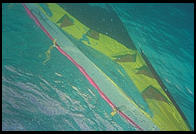
One of the best moments of my life was snorkeling in Kealakekua Bay on the Big Island of Hawaii. This is the bay where Captain Cook was worshipped as a God and subsequently stabbed to death by Hawaiians in 1779. I was about 1/2-mile out in the bay, drifting and look down at three reef sharks, each about six feet in length. They swam off suddenly and I looked up to see that a school of dolphins, perhaps 60 in number, had entered the bay. They were 200 yards away and I started swimming toward them. By the time I'd moved 10 yards, the school was all the way down at the other end of the bay (1/2 mile in the distance).
I gave up.
To my immense joy, the dolphins started coming back. They were heading straight toward me, occasionally one would leap but mostly I just saw 20 dorsal fins out of the water at a time (the other dolphins swimming underneath). My joy eventually turned to fear when I thought that perhaps a direct encounter with 60 bottle-nosed animals traveling at 30 miles-per-hour would not be pleasant. At the last minute, when the dolphins were no more than 15 feet away, they dove about 10 feet underwater and swam directly underneath. Some of them rolled on their sides to get a better look up at me. I snapped their picture with a Nikonos V.
When I got the images back, I found that the dolphins were only faintly visible on film. My eyes had adjusted to the blue light, but the film did not. The contrast between dolphin and water, dramatic to my eye, was very subtle.
If you want to be a great photographer, the general rule is that you should carry a camera at all times. Competing with Christopher Newbert or Norbert Wu is a tall order, however. These guys go into the water every day year after year and wait.
It is difficult to take decent photos on land. It is difficult to go down underwater with tanks on your back and get back to the boat or beach alive. Don't feel compelled to combine these activities, especially if you're going on a dive that is challenging for you. There is nothing wrong with enjoying the underwater scene while you're privileged to be on vacation and underwater.
Text and images copyright Philip Greenspun.